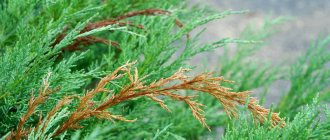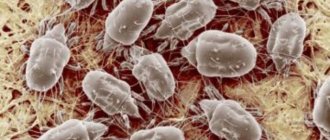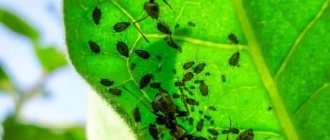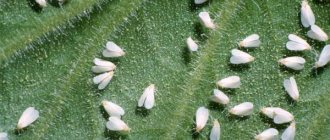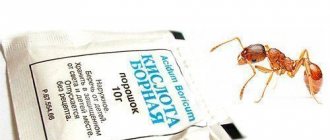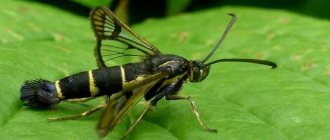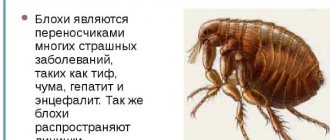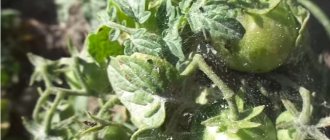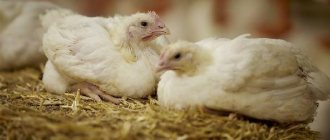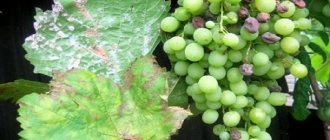The appearance of pests on indoor plants always causes a certain amount of panic in the gardener, accompanied by a search for answers to the question “what to do?” The scale insect on an orchid is not an exception, but a fairly common uninvited guest, which an inexperienced flower owner often does not mistake for a living organism. To understand how to deal with a parasitic insect, and even better, to prevent it from appearing on orchids, you need to know what it looks like and what kind of life it leads.
Description, photo of the parasite and the affected plant
The pest feeds on plant sap. The scale insect is covered with a kind of shield, so it cannot be destroyed simply with a chemical. In the photo you can see what scale insects look like on orchids.
The scale insect sticks to the orchid leaf and drinks juice from it.
Females and males are covered with a shield that protects them from harmful influences. At the same time, males are quite mobile, and females are attached to one place and give birth to children. At one time, a female can produce 3 thousand larvae , which remain mobile for a short period of time.
Use of chemicals
In order to get rid of scale insects on an orchid, you can also use insecticides.
- Contact: “Permethrin”, “Spruzit-AF”. Once on the insect's body, they penetrate the integument and cause paralysis. After some time, the pests die. Such products are highly effective and rid flowers of scale insects in record time.
- Intestinal: “Aktara”, “Aktellik”, “Arrivo”. Their active ingredients begin to work only after they enter the insect’s body. Enteric insecticides are used at least twice at weekly intervals.
- Systemic: “Bi 58”, “Phosfamide”, “Methylmercaptophos”. Used to spray infected plants. Their active substances penetrate the body of the plant and make its juices poisonous to scale insects. And after the parasite drinks the poisoned juices, it dies.
Features of application
Insecticides must be used strictly according to the instructions, taking into account all prescribed precautions. And after treatment, flowers should not be placed on strongly lit windowsills, as direct sunlight can cause burns on the stems and leaves.
If you use preparations that contain oils, then processing in this case should be carried out very carefully. Such solutions are not sprayed in an even layer, but are applied only to the scale insects. Otherwise, the pores on the leaves will be clogged, and the flower will die from oxygen deficiency.
Important! If the remedy you have chosen does not produce positive results, do not remove the scale insects with your hands under any circumstances. Such a procedure can only cause harm - if you accidentally remove or damage the shell under which the masonry is located, the young individuals, after birth, will quickly spread throughout the plant, and the infection will resume with renewed vigor!
Types of scale insects
differs from the false scale insect :
- Scale insects have a convex shell;
- False scale insects have a flat shell.
There are different types of scale insects that are found on orchids:
- Californian;
- Brown;
- Oleander;
- Palm;
- Cactus.
You can add scale insects to your home collection by purchasing a new plant that is already infected and has larvae on it.
IMPORTANT! Any new plant must be quarantined, where it will stand separately from other plants for 2 weeks. This time is necessary to ensure the health of the plant.
Preventive actions
Often, infection with scale insects occurs through new specimens that were purchased at flower shops. For this reason, before purchasing a plant, it is necessary to inspect it carefully. And if warts, bulges, dark spots or sticky honeydew are found on the flower, it is better to discard it.
However, even if no signs of the presence of scale insects have been identified, you should not immediately place the new plant on a shelf with other flowers. He needs to be quarantined for a couple of weeks. This time will be quite enough for parasites, if any, to manifest themselves.
And remember that the main enemies of scale insects are good lighting and humidity. Create the proper conditions for your orchids, and they will immediately become unattractive to pests.
How to identify an infection?
Scale insects prefer the hard leaves of orchids, on which they are located on both sides. They do it like this:
- They stick to one place;
- Pierce the leaf;
- And they suck the juice.
Later, a small hole with a yellow border remains . And there are a lot of such bites. All this causes great harm to the orchid. Since the number of holes grows rapidly and soon the sheet:
- Turns yellow;
- Dries out;
- And it disappears.
If treatment is not started in time, the orchid's leaf may dry out.
In this case, the waste product of the scale insect is a sticky substance located on the leaf plate. It attracts sooty fungus, which further accelerates the death of the plant.
Signs that the plant is affected by scale insects:
- Small parasites attach to all parts of the plant and this is noticeable by the light brown growths;
- When pressed, they are easily removed;
- The leaves have a transparent sticky coating;
- Leaf plates become deformed, fade and turn yellow, starting from the edge of the leaf.
If a scale insect is detected, it is worth starting treatment as quickly as possible so that it does not affect the entire orchid bush.
Species that parasitize orchids
Scale insects affect many orchids, but more often than others they settle on plants with hard elastic leaves: paphiopedilums, dendrobiums, stangopeas, cymbidiums, cattleyas, phalaenopsis, bletillas, pleion.
The most famous types of scale insects seen on orchids are:
Palm tree (Diaspis boisduvalii) is a whitish-yellow or light brown insect. The female's body is short-oval, the scutellum is round. The protective shell of the male is long. More often it settles on palm trees, especially young fan palms, and banana plants, but if an orchid is nearby, it also moves to its foliage.
Palm (Diaspis boisduvalii)
Orchid (Pseudoparlatoria parlatorioides) - the body of the insect is ovoid, the scutellum is rounded and convex, yellowish-brown in color with two larval skins, often extending beyond the scutum. Males have an oblong carapace, with almost parallel opposite edges, the same color as that of the female. Larvae and adult females damage the leaves; yellowish spots form on them around the puncture sites. In addition to orchids, it also parasitizes other plants.
Orchid (Pseudoparlatoria parlatorioides)
Bromeliad (Diaspis bromeliae) – yellowish-cream color, small, only up to 2.5 mm long. The body is pear-shaped and appears translucent. The scutellum is rounded, in the male it is long. Harmful to palm trees, orchids and bromeliads.
Bromeliad (Diaspis bromeliae)
Orchid comma (Lepidosaphes machili) – the female’s body is elongated, but the front part with the head is narrower than the rest. Its scutellum partly follows the shape of the body, curved, in the shape of a comma, expanding towards the back. The male has an elongated carapace. Only affects orchids.
Orchid comma (Lepidosaphes machili)
Oleander (Aspidiotus nerii) - females are yellowish, with a rounded-ovoid shield, males have an elongated shell shape and are covered with reddish spots. They parasitize many plants - olive, palm, orchid, laurel, and are found on yucca, oleander, asparagus, acacia and other plants.
Oleander (Aspidiotus nerii)
The soft scale insect (Coccus hesperidum) is a viviparous insect that can give birth to up to 1 thousand young individuals. The scutellum is flat, elliptical, yellow-brown in color, with a distinct vein in the middle. The insect's body is asymmetrical and broadly elliptical. Settles on leaf blades on the lower and upper sides, on stems and tuberidia.
Soft scale insect (Coccus hesperidum)
Hemispherical false shield (Saissetia coffeae) - named for the shape of a flat-convex shield, reaching a length of 4 mm, smooth and dark brown to blackish in color. After the eggs mature, the female dies, the shell rises, and the larvae crawl at a very fast pace along the leaf or stem.
Hemispherical false scale (Saissetia coffeae)
Control measures
How to get rid of a pest? The first immediate step when a scale insect is detected is to separate the infected specimen into a quarantine zone.
This is necessary so that the males do not run over to neighboring flowers. Especially if the flowers are very dense.
During the entire treatment, the flower is in the quarantine zone and even 2 weeks later remains in it. This is necessary in order to be completely sure that the pest is no longer on the flower.
Way to get rid of scale insects:
- It is necessary to mechanically remove all visible shields, since the chemical will not get under them during processing;
- Wash all leaves and flower stalks with soapy water, getting rid of sticky residue;
- Only after this do they begin to process the plant.
If the infestation is small, then you can try to get rid of the insect using traditional methods , but with a large infestation they do not produce results.
Folk remedies
How to fight scale insects with folk remedies? Since this is not a new pest and people have been fighting it for a long time, there are certain folk remedies to get rid of it.
Garlic juice
To do this, cut off the tip of a clove of garlic and, using the protruding juice, treat the places on the leaf blades where the pest was noticed.
A folk remedy for fighting scale insects is rubbing the orchid leaves with garlic juice.
But if the damage occupies a large area, then the garlic is grated on a fine grater or crushed using another method, the main thing is that it releases juice and turns into pulp. After which this paste is spread on the affected leaf.
Olive oil
To do this, make a composition by mixing 2 tbsp. spoons of oil with a liter of water. The orchid is treated with this infusion with an interval of 7 days.
Soap and alcohol
To do this you need to mix :
- Liter of water;
- And 10 ml. alcohol;
- Adding 15 grams there. liquid soap or dishwashing detergent.
Mix everything thoroughly and wash the plant where the scale insect was noticed.
Biological agents
Fitoverm - fights scale insects quite well. It is used in cases where, for various reasons, it is impossible to carry out chemical treatment, and traditional methods do not help to completely get rid of it. This drug is of biological origin and is not dangerous for humans and their animals.
To make a solution of the drug, 2 ml. diluted in 200 gr. water and spray the affected plant . This drug can be used to treat other plants in the house to prevent the disease. You also need to wipe the place where the affected flower stood.
To completely remove scale insects, treatment is carried out three times after 7 days.
Fitoverm.
Promanal is considered non-toxic and is used at home not only against various types of scale insects, but also helps get rid of ticks and scale insects. It affects egg laying and the larvae die without hatching. When treating an orchid, it must be thoroughly sprayed so that the solution drips from the leaves. In this case, the substrate must also be treated, since it may contain eggs and larvae.
Promanal is a remedy that helps plants fight pests.
Avertin is a broad-spectrum drug designed to remove pests. It affects the nervous system of the pest, causing its paralysis. Processing is carried out according to the instructions indicated on the packaging.
Nemabakt - the weapon of this biological product is a nematode, which penetrates the scale insect larva and eats it. The drug is absolutely harmless to beneficial insects, people and pets. The nematode continues to fight the pest for quite a long time, and the latter has no chance of surviving against it.
Biological drug Nemabact.
Insecticides
If the orchid is completely affected by this harmful insect, then it is worth using chemicals that can save the plant. When working with such drugs, you must be careful and if they come into contact with the mucous membrane or skin of a person, you must rinse everything well under running water.
Permethrin
The drug is quite effective and one treatment is enough to remove the parasite.
Permethrin helps the orchid fight pests well.
Penetrates the scale insect through the skin.
Aktellik and Aktara
These drugs are treated three times with an interval of 5-6 days. It is very toxic and must be processed outside . Penetrates insects through the oral cavity.
Phosfamide and Methylmercaptophos
The drugs enter the insects through the sap of the plant, which becomes poisonous .
Whatever drug is chosen, it is diluted and used according to the instructions given on the package. Experienced flower growers believe that sometimes chemical treatment cannot be avoided when a large area in the greenhouse is infected or the flower itself is severely damaged by pests.
IMPORTANT! There is no need to increase the dosage or frequency of treatments - this can lead to the death of the plant.
Maliciousness
The main source of food for scale insects is plant sap, which they mercilessly suck from both adult and young specimens. Moreover, orchids are their most favorite “dish”. Scale insects appear especially often on those types of orchids whose leaves are hard - on phalaenopsis and cymbidium. And if there are representatives of these varieties in your home greenhouse, it is important to check them more often for the presence of parasites.
As a result of the scale insects feeding, voids are formed in the affected areas of the flower - this is where the pest was located and injected its poison. Small spots, colored yellowish, red and red-brown, begin to appear on the leaves; after a while they increase in size and fill the entire surface. These leaves die.
In addition, the sticky honeydew secreted by scale insects during their life is an ideal environment for the development of fungal diseases of orchids. The disease manifests itself in the form of moldy plaque, which gradually spreads throughout the plant’s body and interferes with the process of photosynthesis. As a result, the infected specimen weakens, the foliage turns yellow and falls off, and the flowers change color. In addition, the sticky secretion is sweet, and therefore attracts the attention of other flower pests - ants. And they, in turn, are capable of transmitting pathogens of viral diseases.
Application of growth stimulants and nitrogen fertilizers
When getting rid of pests, you should not use :
- Various fertilizers;
- Growth stimulants.
At the time of illness, the orchid will not grow new leaves and it will not accept the stimulant. Therefore, an excess of nitrogen fertilizing will lead to softness of the leaf plates and the possibility of their rotting. All the flower needs is a poison that will rid it of the pest.
General information
According to the general encyclopedia, scale insects are small hemiptera insects that belong to the superfamily of scale insects. This name is due to the presence of a hard covering of the body, reminiscent of a shield.
This peculiar shell consists of 1 or 2 connected skins, under which there is a waxy secretory part (scale insects secrete a sticky liquid). False scale insects do not have a hard shell. Instead, insects have a thin shield formed from dying skin. Insects do not secrete liquid, but inject poison into the plant.
REFERENCE! The shell of scale insects is part of the body; it is firmly attached to the body. Pseudoscale insects have a thin shell that can be easily lifted. The sticky substance secreted by scale insects provokes the onset of sooty rot.
Prevention
The best prevention is proper care. By following standard conditions for keeping and caring for the flower, the plant is less susceptible to attacks by pests, including scale insects.
Most often, the parasite infects a plant in a store. You must check the product carefully before purchasing.
If a flower is purchased with affected leaves, then it must be protected from other indoor plants for several months. This will help remove the parasite without a massive epidemic.
How to deal with mealybugs on indoor plants
Each flower is individual, which is reflected in its care, its susceptibility to different types of diseases, and methods of pest control. In order to protect the plant, we will consider individual options for combating parasites, suitable for different types of crops.
How to deal with mealybugs on orchids
The mealybug on the orchid takes root quite quickly. The orchid does not like an abundance of moisture, which creates an ideal microclimate for life for the hairy louse. Having noticed the first signs of the appearance of a parasite on the body of a plant, you need to act immediately. A natural question arises: how to treat an orchid against mealybugs so as not to harm it. In addition to universal chemical compositions, which can be purchased in specialized stores, you can use traditional methods. For example, make a garlic solution or horsetail tincture.
This video describes methods of combating mealybugs on orchids.
https://youtube.com/watch?v=yVF-wDds41M%3F
Orchid petals and stems can be treated with an alcoholic infusion of calendula. To do this, wipe the entire surface of the orchid with a cotton pad soaked in the tincture, carefully removing adults, as well as larvae and plaque.
A hot shower will help against adult hairy lice. The orchid is generously sprayed with hot water (up to 50 degrees), which contributes to the death of insects.
Of the chemicals that have proven effective for treating orchids, Aktara against mealybugs, the main active ingredient of which is thiamethox.
How to deal with mealybugs on violets and cactus
When the first symptoms of violet infection appear, it, like other types of flowers, should be isolated, preventing insects from infecting the entire flower garden. In case of numerous, heavy infestations, it is better to immediately resort to chemical agents. If the location of the hairy louse is small, you first need to remove the infected leaves, then proceed to treatment with solutions.
Mealybug on a cactus
Try preparing a decoction of hot red pepper; it has a gentle effect on violets and is good at controlling pests. 30 grams of pepper are crushed, poured with a small amount of water, and boiled over low heat for about an hour. The prepared decoction is infused for a day. The resulting liquid is used to process the violet in several stages until complete recovery.
The above folk remedies for pest control are suitable for cacti. You can also try using a mixture of vegetable oil. Two tablespoons of vegetable oil (olive) are added per liter of water. The cactus is sprayed with the prepared solution several times a day. For each spraying, a fresh mixture is prepared.
Mealybug on ficus
To begin with, ficus leaves are treated with a soap solution (it is better to use 72% laundry soap). After thoroughly soaping and removing visible insects and larvae, the ficus is given a generous shower. Dried sheets are treated with Actellik. Treatment will take about a month, the procedure should be repeated 3-4 times with an interval of at least 7 days.
Mealybug on boxwood
Boxwood has a large number of small leaves, as well as branched shoots; it cannot be effectively wiped with homemade solutions. It is better to use chemical compounds. Fitoverm treatment of boxwood against mealybugs is quite effective and safe for humans. Its active component is imidacloprid, which allows you to reliably protect the flower from pests.
How to deal with mealybugs on lemon
Having seen the affected areas on an indoor lemon, the question immediately arises of how to remove mealybugs from a lemon. All of the above folk methods and most chemical compositions are suitable for citrus crops.
Photo of mealybug on lemon leaves
A tincture of citrus fruit zest is also effective. Orange and lemon peels are poured with boiling water at the rate of 1 liter of water per 35 grams of peel. The liquid is infused for a day, then filtered. The lemon tree is treated with the finished tincture several times a day.
There are many recipes for exterminating the pest, but the main thing to remember is that you must follow the rules of caring for flowers, regularly carry out disease prevention, then the question of how to deal with mealybugs will never arise.
Determining the presence of a pest
Unlike many other insects, adult male and female scale insects have quite significant differences. Males can move freely, moreover, they are winged, and therefore are able to cover distances of several meters. The females are motionless - they attach their proboscis to the body of the plant and no longer move.
Scale insects can be recognized by the translucent shell that covers their body. Moreover, its color can vary - from white to almost black. The shade of the shell will depend on the species of the parasite.
Female scale insects are called shield aphids. They have small body sizes - from 0.5 to 5 mm and are capable of producing a waxy substance. This honeydew accumulates around the female’s body, forming a kind of shield that protects both herself and the egg laying.
Young individuals - larvae - do not yet have a shell, and therefore can move freely around the plant. Over time, female scale insects stick to the chosen place on the orchid with their proboscis, and the males continue their active lifestyle.
What danger does the insect pose?
Scale insects provoke the onset of sooty rot of the plant:
- The insect secretes a sticky liquid, which is an ideal environment for the appearance of fungi.
- Sticky feces disrupt photosynthesis processes and stop flowering.
- The false scale insect injects poison into the orchid, under the influence of which the leaves become covered with multi-colored spots.
- As the area of such spots increases, the leaf dies.
The affected plant is an excellent food for ants. The pest larvae quickly spread and infect neighboring bushes.
Aphid
Aphids on an orchid can also be seen with the naked eye: these are small green or black insects that most often settle on the underside of young leaves, sprouts and flowers of the plant. The presence of aphids can be determined by the following signs: the orchid leaves become deformed and become sticky. Like scale insects, aphids suck the juices out of the orchid and inject a toxic substance inside that destroys the plant cells. Insects are also dangerous because they are carriers of viral diseases and fungi.
How to get rid of aphids
If you find pests when there are not too many of them yet, then thoroughly “bathing” the entire plant in the shower will help you deal with aphids. In this case, damaged flowers and buds from the orchid must be removed.
If there are a large number of insects, it is worth using a soap solution. It acts as an antiseptic, which is detrimental to many insects. You can treat the orchid either with laundry soap foam or with dishwashing liquid diluted in 1 liter of water (1 tbsp). After such treatment, it is recommended to spray the flower with Fitoverm or a solution of the drug Alatar.
Aphids on orchid leaves
Folk remedies
You can cope with aphids on an orchid using infusions. For example, onion infusion, which is prepared from an onion crushed into pulp, is poured with boiling water and infused for about 7 hours. The strained product should be sprayed on the orchid for 3-4 days several times a day.
Another effective infusion is prepared from citrus peels. Dried zest of lemons, oranges or tangerines (100 g) should be poured into 1 liter of water and left for 3 days. After this, the resulting infusion must be sprayed on the aphid-damaged orchid for several days every 4-5 hours. To consolidate the effect, dry citrus peels can be placed on the soil in a pot.
In order to protect the orchid from aphids, the tropical plant must be kept in conditions favorable to it.
In particular, it is extremely important to ensure sufficient humidity in the room - from 60% and above. Sufficient watering and timely fertilizing are also necessary.
Instructions
First you need to prepare the solution, observing the dosage:
- The granular product must be diluted. Typically, flower growers take a 1.4 g sachet. Prepare a mother solution - part of the granules is dissolved in a small amount of water. Then it is brought to the required volume by adding the remaining dry matter and water according to the instructions. Shake well before use.
- The liquid product should be diluted in the same proportions and dosage as the granular product.
- For spraying, the optimal dose is 1 g per 10 liters of water. This amount is enough to process about 120 plants. If you need to water at the root, use 4 g per bucket of water.
